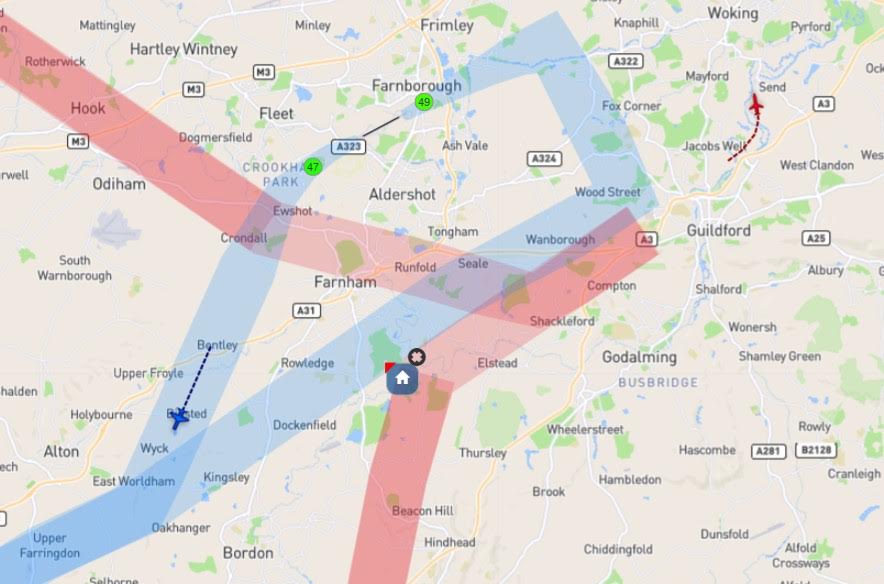 Abraham Lincoln
If given the truth, the people can be depended upon to meet any national crisis...
Abraham Lincoln
If given the truth, the people can be depended upon to meet any national crisis...
 Guildford news...
for Guildford people, brought to you by Guildford reporters - Guildford's own news service
Guildford news...
for Guildford people, brought to you by Guildford reporters - Guildford's own news service
Letter: What Happened to the Peace and Quiet?
Published on: 12 Jan, 2022
Updated on: 12 Jan, 2022
From: Colin Shearn
Farnborough Noise Group
A lot of people around Guildford have been noticing the increased noise of planes during the past year. “What’s changed?” they may ask. Two things.
First, since 2010, Farnborough Airport has been steadily growing as the UK’s largest airport for private jets and it currently has a licence for 50,000 flights a year. That’s an average of about 140 flights a day but there are no restrictions on how many flights there are per day or per hour so it peaks at more than that.
The lockdown has been a boom for Farnborough with ultra-high net worth users avoiding commercial flights. So there is increased noise from more aircraft using Farnborough.
Second, the Civil Aviation Authority carried out a consultation in 2014 to change the airspace around here. Very few people knew about it and the response rate was less than 0.5 per cent with 98 per cent of responses against it.
But despite objections, the changes were introduced through Spring /Summer 2020 and this has meant that aircraft going into and out of Farnborough fly over Guildford at 2,000ft – 3,000ft. So there is more noise because the new routes for Farnborough aircraft go over Guildford.
But that’s not the only impact the change in airspace has had. Other aircraft (light aircraft, helicopters, etc) now have to either get permission to fly through this controlled airspace or fly under/around it.
The intention was that most aircraft would fly through the controlled airspace, but they aren’t. With the varying ground height of the North Downs and the limited height under the controlled airspace, aircraft are using the gap in the North Downs above Guildford to fly in a corridor from places like London, and Biggin Hill in Kent, over Guildford, to airfields in the south and west.
This is uncontrolled airspace so there are microlites at 40mph mixing with helicopters flying at 180mph at the same height. It’s a bit like pedestrians and cars using a motorway with no road marking.
These aircraft are flying lower and they are funnelled over Guildford so there is more noise from them. Of course, it isn’t just the noise. There are an average of 2.4 passengers per plane using Farnborough so that equates to about 18 times more fuel per passenger compared to a commercial flight on the same route.
Private jets are at the top of the pile when it comes to greenhouse gas emitters. The 2014 consultation was carried out before the UK committed to be net-zero by 2050 and the World Health Organisation halved the safe levels of airborne pollution in 2021. The pollution monitoring stations around Farnborough are currently recording levels that are double and sometimes up to four times the safe levels.
A post-implementation review was to be carried out a year after the new flight paths were introduced to determine what impact the changes have had. It was delayed by a year due to Covid and it should start in February but there has been no information about the scope of the review, who to contact and when.
To find out more about what’s going on, there is a Facebook page (https://www.facebook.com/groups/505992344059468) or email: FarnboroughNoise@gmail.com to join the newsletter.
There is also a petition against the changes at Farnborough (https://chng.it/5jLR6HKbC5).
Recent Articles
- Guildford Institute’s Crowdfunding Project for Accessible Toilet in its New Community and Wellbeing Centre
- Letter: Guildford – Another Opportunity Missed?
- Letter: GBC’s Corporate Strategy – Where Is the Ambition?
- My Memories of John Mayall at a Ground-breaking Gig in Guildford Nearly Six Decades Ago
- Westborough HMO Plans ‘Losing the Heart of the Street’ Says Resident
- College Invests to Boost Surrey’s Economy and Close Digital Skills Gap
- Community Lottery Brings Big Wins for Local Charities
- GBC Housing Plan Promises ‘A Vibrant Urban Neighbourhood’ Near Town Centre
- Hospital Pillows ‘Shortage’ at the Royal Surrey
- Updated: Caravans Set Up Camp at Ash Manor School


Search in Site
Media Gallery
Dragon Interview: Local Artist Leaves Her Mark At One of England’s Most Historic Buildings
January 21, 2023 / No Comment / Read MoreDragon Interview: Lib Dem Planning Chair: ‘Current Policy Doesn’t Work for Local People’
January 19, 2023 / No Comment / Read MoreA3 Tunnel in Guildford ‘Necessary’ for New Homes, Says Guildford’s MP
January 10, 2023 / No Comment / Read More‘Madness’ for London Road Scheme to Go Ahead Against ‘Huge Opposition’, Says SCC Leader
January 6, 2023 / No Comment / Read MoreCouncillor’s Son Starts Campaign for More Consultation on North Street Plan
December 30, 2022 / No Comment / Read MoreCounty Council Climbs Down Over London Road Works – Further ‘Engagement’ Period Announced
December 14, 2022 / No Comment / Read MoreDragon Interview: GBC Reaction to the Government’s Expected Decision to Relax Housing Targets
December 7, 2022 / No Comment / Read MoreHow Can Our Town Centre Businesses Recover? Watch the Shop Front Debate
May 18, 2020 / No Comment / Read More










Recent Comments